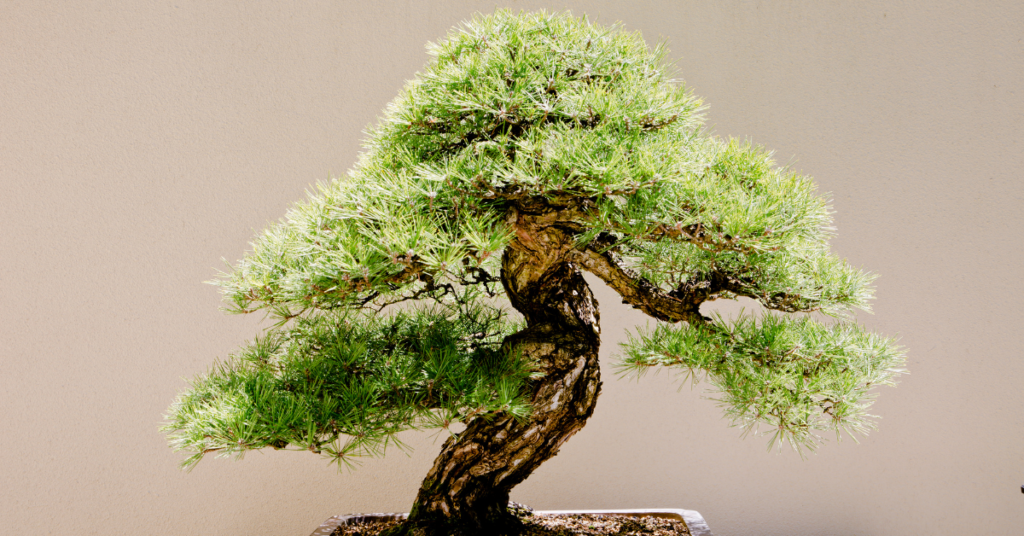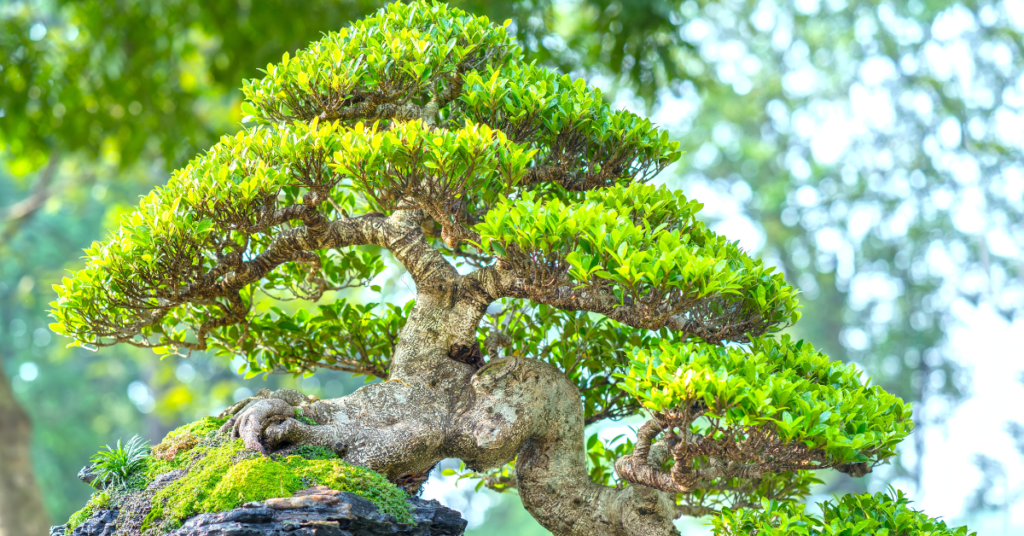Have you noticed your beloved bonsai turning brown and starting to wither away? It’s a common problem that can be concerning for any plant enthusiast.
But don’t worry, there are a variety of reasons why your bonsai may be turning brown, and some simple solutions to get it back on track.
One possible reason for a browning bonsai is over or underwatering. Bonsais require specific amounts of water, and too much or too little can cause stress leading to brown leaves.
Another possibility is improper lighting or placement of the plant. Bonsais need adequate sunlight but also protection from harsh direct light, as well as proper ventilation.
Additionally, pests and diseases can also cause browning in bonsais. By identifying the underlying issue causing your bonsai to turn brown, you can take steps to revive it and enjoy its beauty for years to come.
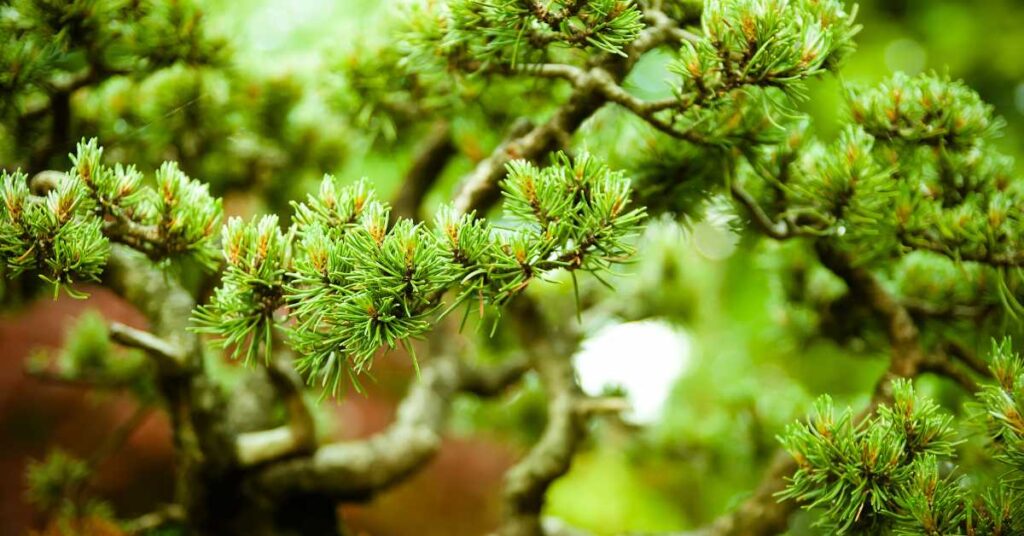
Signs Of A Dying Bonsai
Did you know that up to 90% of bonsai trees die within the first year of ownership? That’s right, despite their popularity and beauty, these delicate plants require a lot of care and attention.
One of the most common signs that your bonsai is struggling is if its leaves start turning brown. There are a few different reasons why this might be happening.
First, it could be related to watering – either too much or too little can cause stress on the tree. Make sure you’re giving your bonsai enough water but not drowning it, and consider using a humidity tray to keep moisture levels consistent.
Additionally, lack of sunlight or improper fertilization can also lead to browning leaves. Reviving techniques such as trimming dead branches and leaves, adjusting lighting conditions, and providing proper nutrients can help bring your bonsai back to life.
Overwatering: A Common Culprit
As mentioned earlier, a dying bonsai can exhibit various signs, including browning leaves. However, one of the most common reasons for this issue is overwatering. When a bonsai is watered too frequently or excessively, its roots become waterlogged and start to rot. This impedes the tree’s ability to absorb nutrients and causes its leaves to turn brown.
To prevent overwatering, it is essential to ensure proper soil drainage. Bonsai trees require well-draining soil that allows water to seep through quickly. If the soil is too dense or compacted, it can trap moisture and cause root rot. Therefore, it is crucial to choose the right type of soil for your bonsai and use a pot with adequate drainage holes.
Additionally, regular bonsai pruning can help promote healthy growth by removing dead or diseased branches and thinning out dense foliage that can block sunlight and air circulation.
Remember that taking care of your bonsai requires patience and attention to detail. By avoiding overwatering and ensuring proper soil drainage while practicing regular pruning techniques, you can keep your bonsai healthy and vibrant for years to come.
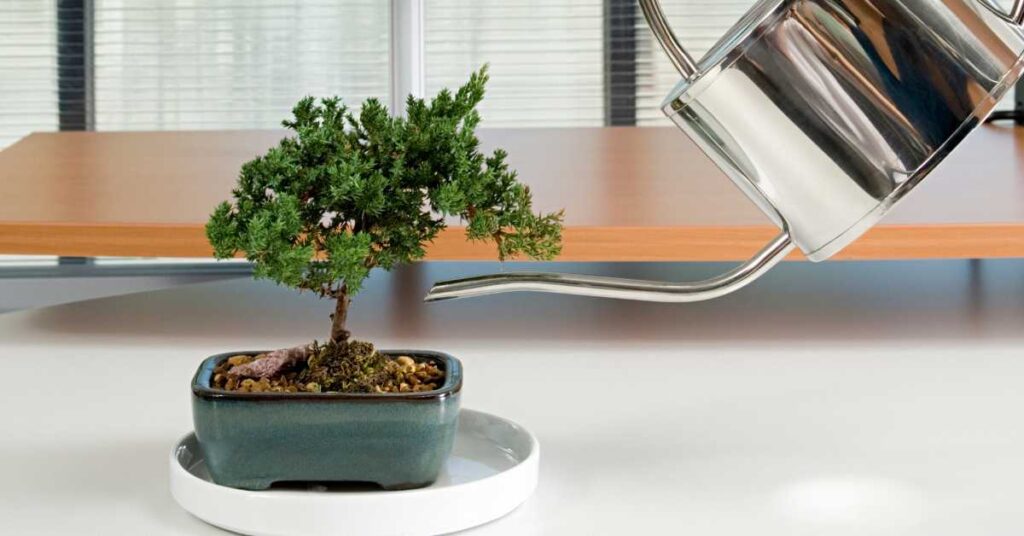
Underwatering: Another Possible Cause
Underwatering is another possible cause for a bonsai turning brown. If you notice that the soil is dry to the touch and the leaves are wilting or turning yellow, it may be time to water your plant. Watering frequency and soil moisture are two factors to consider when preventing underwatering in bonsais.
To avoid underwatering, make sure you are watering your bonsai regularly. The frequency of watering will depend on several factors such as the size of your pot, the type of soil used, and the environment conditions.
Here are four tips for preventing underwatering in your bonsai:
- Check the soil moisture regularly by sticking your finger about an inch into the soil.
- Use a moisture meter to accurately measure the soil’s moisture level.
- Water your plant thoroughly until water drains out of the bottom of the pot.
- Consider using a humidity tray or misting your plant to increase humidity levels around it.
By following these tips and monitoring watering frequency and soil moisture, you can prevent underwatering in your bonsai and keep it healthy and vibrant.
Proper Watering Techniques For Bonsai Trees
When it comes to watering bonsais, it is crucial to maintain a consistent watering schedule. Over-watering can lead to root rot, while under-watering can cause the leaves to turn brown and dry out.
One effective way to water your bonsai is through the immersion technique. This involves submerging the pot in a container of water for about 10-15 minutes or until bubbles stop rising from the soil. Afterward, allow excess water to drain out completely before placing it back in its designated spot.
Aside from proper watering techniques, misting is also important in maintaining a healthy bonsai. Misting involves spraying water on the foliage using a spray bottle or mister. This helps increase humidity levels around the plant and keeps its leaves moist and shiny. However, be sure not to mist too much as it may lead to fungal growth or disease.
Additionally, fertilizing your bonsai regularly is essential as it provides nutrients that aid in growth and development. Use a balanced fertilizer during the growing season and reduce frequency during winter months when growth slows down.
By following these techniques, you can ensure that your bonsai remains healthy and vibrant for years to come!
Lighting Requirements For Bonsai Trees
As we have learned in the previous section, proper watering techniques are crucial for maintaining the health of your bonsai tree. However, if you find that your bonsai is turning brown despite following these techniques, then it may be time to examine the lighting requirements of your plant.
Bonsais thrive in bright, indirect sunlight. If your plant is not receiving enough light or too much direct sunlight, then it can lead to browning of the leaves and ultimately result in the death of your bonsai. It is important to note that different species of bonsais have varying lighting needs, so research on the specific requirements of your plant is necessary.
Additionally, proper Bonsai pruning and soil also play a significant role in maintaining its overall health and preventing browning.
To further emphasize this point, consider these nested bullet points:
Bonsai pruning:
- Regular pruning helps maintain the shape and size of your bonsai.
- It also promotes healthy growth and development of new branches and foliage.
Bonsai soil:
- The type of soil used can affect water drainage and nutrient absorption.
- Using a well-draining soil mix with adequate nutrients can prevent root rot and promote healthy growth.
Incorporating these practices alongside proper watering techniques and monitoring lighting requirements will help keep your bonsai healthy and vibrant. Remember to research on the specific needs of your plant regularly to ensure optimal growth conditions.
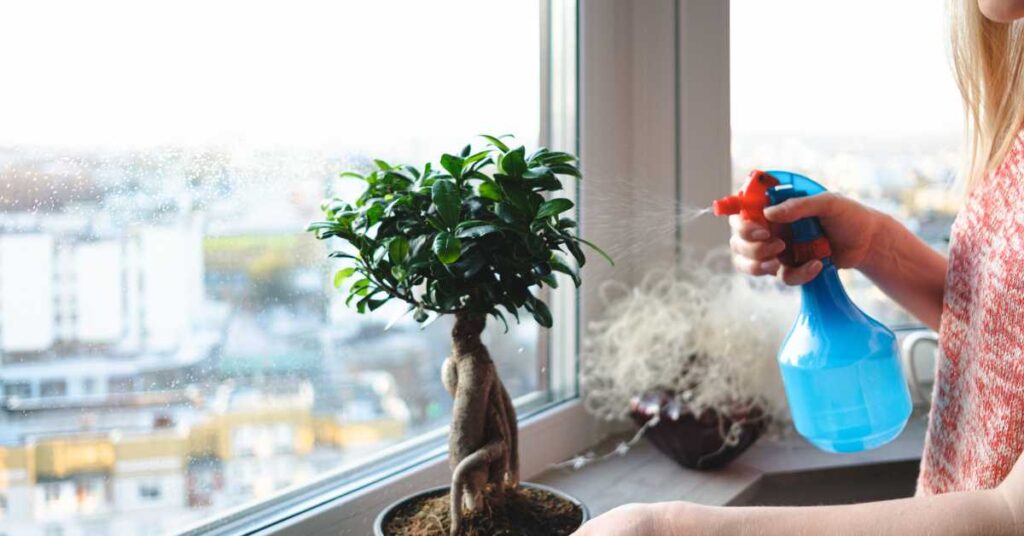
Ideal Placement For Your Bonsai
So, your bonsai is turning brown. Congratulations, you’ve achieved what every bonsai lover dreads – killing their beloved miniature tree. But fear not, my dear friend, for the fault may not entirely lie with you. Sure, over or underwatering could be the reason behind your bonsai’s demise. But have you considered its placement?
Yes, the location of your bonsai can often make or break its well-being. Remember, these delicate plants need just the right amount of sunlight and shade to thrive. Placing it on a windowsill that gets too much direct sunlight or in a corner that receives no light at all will only spell doom for your little green friend. So before you start panicking and calling yourself a plant murderer, let’s look at some ideal placements for your bonsai.
| Bonsai Type | Ideal Placement | Unsuitable Placement |
|---|---|---|
| Juniper | Brightly lit room with ample indirect sunlight | Direct sunlight or dark corners |
| Maple | Shaded area with some morning sun exposure | Too much sun exposure or indoors without any natural light |
| Pine | Partially shaded area with good air circulation | Direct sunlight or indoors without proper ventilation |
| Ficus | Brightly lit room with moderate temperature and humidity levels | Dark corners or areas prone to drafts |
Now that we’ve established the importance of proper placement for your bonsai’s survival let’s delve into another aspect – soil composition. Bonsai pruning may be an art form but soil composition is a science. The right soil mix can provide essential nutrients and retain moisture while allowing proper drainage to avoid root rot.
A good rule of thumb is to use a mix of Akadama, Pumice, and Lava rock in equal proportions for optimal growth. So next time you’re potting your bonsai ensure that you have the correct soil mix to give it the best chance at life.
Remember, a bonsai is like a pet – it needs to be taken care of with love and attention. With proper placement and soil composition, you can ensure that your miniature tree will flourish and bring joy to your life for years to come.
Identifying Pests And Diseases
If your bonsai is turning brown, it could be a sign of pests or diseases. Identifying the problem early on is crucial to saving your plant.
Here are some common pests and diseases that can affect bonsais:
- Spider mites: These tiny bugs can cause webbing and yellowing leaves.
- Mealybugs: These white insects will feed on your plant’s sap, causing stunted growth.
- Root rot: Overwatering or poor drainage can lead to root rot, which causes wilting and discoloration.
- Fungal disease: This can cause black spots on leaves and stem, as well as yellowing and wilting.
Natural remedies such as neem oil or insecticidal soap may help control pests, but if the infestation is severe, you may need professional assistance. Similarly, if you suspect a fungal infection or root rot, consulting with a professional bonsai expert is recommended.
Remember to always properly clean your tools and avoid cross-contamination when handling diseased plants. With proper care and attention, your bonsai can thrive for years to come.
Treating Pests And Diseases
Preventative measures are the best way to keep pests and diseases from affecting your bonsai. Regularly inspecting your tree for any signs of trouble is essential in catching issues early. Keeping a clean and tidy environment around your bonsai can also prevent pests from making themselves at home. Ensure that your bonsai is receiving the proper amount of light, water, and nutrients to keep it healthy and strong.
If you do notice pests or diseases on your bonsai, there are natural remedies that can be used to treat them. One option is using neem oil, which is an effective insecticide and fungicide. Another option is creating a garlic spray by blending garlic cloves with water and spraying it onto the affected areas. Additionally, using beneficial insects such as ladybugs or praying mantises can help control pest populations.
| Pest/Disease | Prevention | Treatment |
|---|---|---|
| Spider Mites | Keep humidity levels high to deter them | Use neem oil or predatory mites |
| Root Rot | Ensure proper drainage and avoid overwatering | Repot in fresh, well-draining soil |
| Scale Insects | Regularly inspect for signs of infestation | Use rubbing alcohol to wipe off scales |
| Powdery Mildew | Avoid overhead watering and promote air circulation | Use a milk spray or baking soda solution |
Preventing pests and diseases from affecting your bonsai involves taking proactive steps such as regularly inspecting your tree and maintaining its environment. If treatment is necessary, there are natural remedies available that can effectively control pest populations without harming your tree. Remember that prevention is always better than cure when it comes to keeping your bonsai healthy and thriving.
Reviving Your Bonsai
Well, well, well, looks like someone’s bonsai is turning brown. Congratulations! You’ve officially become a member of the club.
Don’t worry; it happens to the best of us. But before you throw in the towel and give up on your plant, let me tell you that there’s still hope.
The key to reviving your bonsai lies in two things: pruning techniques and fertilizing methods. Pruning helps remove dead or unhealthy branches and promotes new growth, while fertilizing provides essential nutrients for healthy leaves and roots.
Make sure to prune regularly, especially during growing seasons, and use a balanced fertilizer according to your plant’s needs. With a little bit of patience and care, your bonsai will be back to its vibrant self in no time!

Preventing Future Issues With Your Bonsai
Choosing the right soil type is crucial in maintaining a healthy bonsai. It is important to select a soil mix that provides proper drainage, aeration, and moisture retention. A good soil mix should be able to retain enough water for your bonsai to absorb but also allow excess water to drain away quickly. You can choose from pre-made bonsai soil mixes or create your own by mixing components such as Akadama, pumice, and lava rock.
Fertilizing techniques for bonsais are also critical in promoting healthy growth and preventing future issues. Bonsais require regular fertilization during their growing season, which is usually from early spring to mid-fall.
Use a balanced fertilizer with equal amounts of nitrogen, phosphorus, and potassium every two weeks or follow the instructions on the packaging. Over-fertilization can cause root burn or damage, so be careful not to apply too much fertilizer at once.
By choosing the right soil type and fertilizing techniques for your bonsai, you can prevent future issues and ensure that your tree thrives for years to come.
Frequently Asked Questions
Can I Use Tap Water To Water My Bonsai?
When it comes to bonsai watering techniques, using tap water can be a bit tricky. While tap water is convenient and readily available, it may not always be the best option for your bonsai.
The quality of tap water can vary depending on where you live and what impurities are present in the water. Some tap water may contain high levels of chlorine, which can damage the roots of your bonsai over time.
To ensure the health and longevity of your bonsai tree, consider using filtered or distilled water instead of tap water. By taking this simple step, you can help prevent issues like brown leaves or stunted growth caused by poor watering habits.
Can I Use Fertilizer On My Dying Bonsai?
If your bonsai is dying, you may be wondering if using pesticides is the answer. While pesticides can certainly help with certain issues, it’s important to identify the specific problem before treating it.
In some cases, lack of proper care or over-fertilization can cause a bonsai to wilt and turn brown. In these situations, using fertilizer may not be the best solution. Instead, consider adjusting your watering schedule and ensuring that the plant has enough sunlight and nutrients from a balanced diet.
With patience and care, you may be able to revive your dying bonsai without resorting to pesticides or fertilizers.
Can I Prune My Bonsai During The Winter?
Pruning your bonsai during the winter may seem like a crazy idea, but in fact, it can offer some amazing benefits! Not only will it help keep your plant healthy and strong, but it can also promote new growth and help shape your little tree into something truly spectacular.
Of course, there are some tips you’ll want to keep in mind if you decide to go this route. For example, make sure you’re working with sharp tools and that you’re only removing small amounts of growth at a time. Additionally, be sure to prune at the right time – when your bonsai is dormant – so as not to cause any harm.
By following these simple tips for pruning bonsai during dormancy, you’ll be well on your way to creating a work of art that will bring joy and beauty into your life for years to come!
Can I Repot My Bonsai During The Summer?
Yes, you can repot your bonsai during the summer. Summer repotting is actually recommended by many experts as it allows the roots to establish themselves in new soil before the colder months arrive.
However, it’s important to use proper bonsai soil and follow proper summer care for your tree to avoid damaging it further. Brown leaves may indicate that your bonsai is experiencing some stress, so addressing the issue through proper summer care and repotting with fresh bonsai soil may help.
Can I Keep My Bonsai Indoors All Year Round?
Yes, you can keep your bonsai indoors all year round if you provide it with the proper lighting that it needs. When it comes to growing plants indoors all year round, the challenge is lighting. Bonsai trees need plenty of sun exposure so be sure to place your bonsai by a window that gets a ton of natural light.
Conclusion
In conclusion, if you find your bonsai turning brown, don’t panic. It’s a common issue that can be easily fixed. Remember to use filtered water and avoid tap water with high levels of chlorine or fluoride.
Fertilizing your bonsai is also crucial for its health, but make sure not to overdo it. Pruning and repotting should be done at the appropriate time of year, so do your research before making any drastic changes.
Overall, taking care of a bonsai requires patience and dedication. But the reward of seeing a healthy and thriving miniature tree is worth it. So don’t give up on your little green friend – with proper care and attention, your bonsai will continue to bring joy and beauty into your life for years to come.


